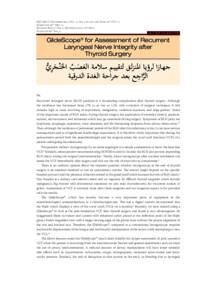Document
GlideScope® for assessment of recurrent laryngeal nerve integrity after thyroid surgery.
Contributors
Other titles
جهازا لرؤيا المنزلق لتقييم سلامة العَصَبُ الحَنْجَرِيُّ الرَّاجِع بعد جراحة الغدة الدرقية
Publisher
College of Medicine, Sultan Qaboos University.
Gregorian
2011-11
Language
English
Subject
English abstract
Recurrent laryngeal nerve (RLN) paralysis is a devastating complication after thyroid surgery. Although
the incidence has decreased from 17% to as low as 1.5% with evolution of surgical technique, it still
remains high in cases involving re-exploration, malignancy, radiation exposure, and large goitres.1 Some
of the important causes of RLN injury during thyroid surgery are application of excessive stretch, pressure,
suction, electrocautery and ischaemia which may go unnoticed during surgery. Symptoms of RLN palsy are
dysphonia, dysphagia, aspiration, voice alteration and life threatening dyspnoea from airway obstruction.1,2
Thus, although the incidence of permanent paresis of the RLN after thyroidectomy is low, it can have serious
consequences and is of significant medicolegal importance. It is therefore vitally important that during the
perioperative period both the anaesthesiologist and the surgeon assess the vocal cord function (VCF) of a
patient undergoing thyroidectomy.
Member of
ISSN
2075-051X
Resource URL
Citation
Tawfic, Qutaiba A., Bhakta, Pradipta, Mishr, Pragyandipta, & Ahmed, Mooyad A. (2011). GlideScope® for Assessment of Recurrent Laryngeal Nerve Integrity after Thyroid Surgery. Sultan Qaboos University Medical Journal, 11 (4), 527–528.
Category
Journal articles

